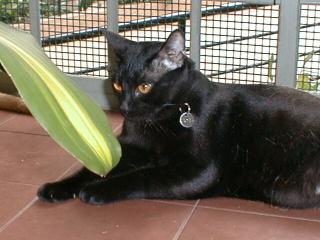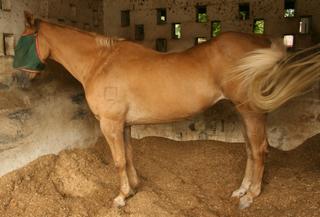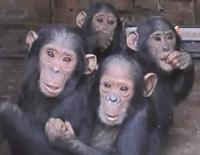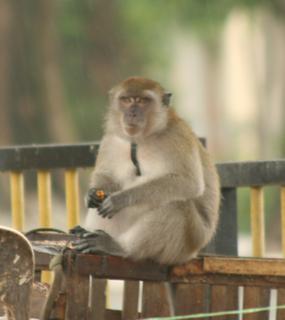
Waris Dirie: Nomad, Supermodel, Activist
“Allah saved me from a lion in the desert after I ran away from home and since this experience I have known that He has got something in mind for me, that there is a reason why I was allowed to live on.”
My
article about Waris Dirie, her new book,
Desert Children, and her fight against female genital mutilation appeared in today's Star Mag. Below is the slightly longer original version, which includes more of Waris's remarks and a comment about FGM in Malaysia.
Desert Warrior
Waris Dirie was born into a family of desert nomads in Somalia. Growing up, she endured hunger, physical and sexual abuse and female genital mutilation (FGM). At the age of 13, she fled into the desert rather than be forced into marriage with an older man chosen by her father. Her story might have ended there. She might’ve been killed by a lion or died of dehydration. The world might never have heard of Waris Dirie.
Instead, the desert was only the beginning. She survived and became an internationally famous model, UN Special Ambassador against FGM and best-selling author. She told the story of her childhood and her escape in her first book, Desert Flower (1999). Her second book, Desert Dawn (2002), chronicled her return to war-and-famine-ravaged Somalia to find her family, twenty years later.
Her new book, Desert Children, written with journalist Corinna Milborn, focuses on the hidden problem of FGM in Europe. What their investigation revealed is staggering: an estimated 500,000 women and girls in the European Union have either already undergone FGM or are at risk of it. According to The Waris Dirie Foundation, 75,000 of them live in Great Britain, 65,000 in France and 30,000 in Germany.
“We have had an avalanche of reaction to the book,” Waris says. “The general public and media simply did not know that FGM was an issue here and were shocked that half a million women in Europe are affected by this harmful practice.”
The medical and healthcare community in the EU suffers from widespread ignorance and insensitivity about FGM. Waris and her team found doctors who were willing to sew a woman’s vagina shut again after childbirth at the request of the husband. Even those with good intentions had little clue about the long-term physical, emotional and psychological effects of FGM. This book may be changing that.
Waris says, “Many professionals – doctors, nurses, social workers – are now eager to know more, and I think we have really changed the perspective of quite a few of them.”
The victims are immigrants and the children of immigrants. The parents either send their daughters back to Africa for the procedure, thereby hoping to avoid scrutiny, or have it performed in Europe, by traditional practitioners or by Western doctors willing to do it on the sly. Currently, only six countries in the EU have laws specifically prohibiting FGM: Austria, Belgium, France, Norway, Sweden and the UK. Of these, only France has been at all active in prosecuting offenders. No EU country recognizes the threat of FGM as grounds for asylum.

“On the political side,” Waris says, “the reaction [to the book] has not been nearly as strong. I think European countries still have to go through the process of admitting to themselves that FGM is their problem, too, before they will start really doing something about it.”
It was the response of the victims themselves that most deeply affected Waris. “Many of them were encouraged to talk about their problems for the first time,” she says. “It was the first time they could admit yes, it was done to them, and, yes, it was awful, painful and wrong. This is a very important step, as much for the women as for their daughters. A woman who truly knows what FGM means will not do it to her daughters.”
Waris is pushing for both tougher laws and more education on the issue. “Without tough laws, education will lead to nothing,” she points out. “How can you tell people something is a horrible crime if it is not even punishable by law? On the other hand, laws without education are equally fruitless. We have met so many people who did not even know about the laws against FGM – how are they supposed to follow them?”
Desert Children does not cover the occurrence of FGM outside Africa and the EU, but Waris is quick to point out that all countries must face the issue. “FGM is a big, big problem among African immigrants to North America,” she says. “It is quite as widespread there as it is in Europe or elsewhere. The USA and Canada must definitely play a role in ending FGM.”
Because FGM is widely practiced in heavily Muslim parts of the world, it is often mistaken for a Muslim practice, although in Africa, animists and Christians also follow the tradition. “Islam,” Waris says, “does not really have anything to do with FGM, or, at least, it should not. The Koran does not even mention it. But there are Muslim preachers who advice parents to mutilate their daughters. I really hope that all religious leaders around the world will stand up and say NO to this. There is nothing as strong as the word of a religious leader in these very religious communities.”
On the personal side, Waris says she has not been back to Somalia since the trip she wrote about in
Desert Dawn. “It hurts, but Somalia is in a very difficult situation. There is no government, no law, no security at all. I really hope that I can go back next year and finally see my family again!”
Living as she does at the forefront of this battle, it would be easy for her to be overwhelmed by the enormity of the campaign she is waging. She admits that, sometimes, she wishes she could lead a quiet, private life with her son and not have to keep up the struggle.
“Luckily,” she says, “I am able to take breaks, listen to music, dance, be with friends and not think about my campaign for days at a time – and this recharges my batteries. On the other hand, every time I see a little girl I might have saved, it gives me a huge push forward.” She knows what her priorities are.
“There is nothing as motivating as saving lives, is there?”
To learn more about FGM, visit The Waris Dirie Foundation website at
http://www.waris-dirie-foundation.com/ or e-mail Waris at
waris@utanet.at.
What is FGM?
The World Health Organisation (WHO) defines female genital mutilation as any procedure under which the female genitalia are wholly or partly removed or damaged, whether for cultural reasons or any reasons other than medical.
FGM includes a range of practices, depending on cultural and geographic background. Eighty percent of FGM victims suffer cutting or excision of the clitoral hood, the clitoris and/or the labia minora, in whole or in part. Other procedures may include incision, perforation, nicking, stretching, scarring of the genitalia with burns, scraping away the flesh from the vaginal opening, or introducing corrosive substances or herbs to the vagina to tighten it.
In Somalia, where Waris Dirie is from, infibulation, the most severe and potentially fatal form of FGM, is practiced. This involves cutting away part or most of the genitalia, including the inner labia. The outer labia are sewn together, leaving only a minute hole for urine and menstrual blood to pass out. The procedure is commonly done without anaesthesia or antiseptics, using a razor blade, knife or piece of glass.
If the girl survives the procedure and any subsequent infections, scar tissue will cover her genital area, leaving it smooth and unfeeling. The nerve damage involved means that she will never experience normal sexual pleasure. Instead, she will endure a lifetime of excruciating pain while urinating, during her periods, during sexual intercourse and when she gives birth. On her wedding night, her husband will either force his way through the barrier with his penis or cut her open again with a knife. Fifteen percent of all FGM victims suffer infibulation.
FGM in Malaysia
According to Waris Dirie, three percent of girls in Malaysia are victims of FGM, making it one of the hot spots for this issue in Asia. “I do not know whether this is due to immigration or other factors, but I do know that Malaysia has a lot of work to do to stop it! I would very much appreciate action by the government. It is definitely necessary.”
The ‘Designer Vagina’Ironically, while women from Africa and elsewhere are fighting to protect themselves from genital mutilation, Waris found some Western women paying cosmetic surgeons to alter their genitals in a bizarre quest for the “designer” vagina, often disturbingly similar to what is achieved by the most extreme form of FGM: a smooth, tight, almost childlike genital area. Surgical techniques originally developed to help those with medical problems are being used to alter the genitals of healthy, but body-image obsessed, women despite the risk of long-term pain, loss of sexual feeling and other complications.




























 Support the SPCA's campaign for
higher fines and longer jail terms
for animal abusers.
Support the SPCA's campaign for
higher fines and longer jail terms
for animal abusers.













